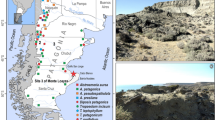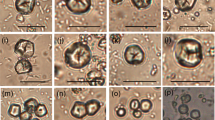Abstract
Starch granules (also called grains) are the stored carbohydrate food of many plants. Starch granules, which are microscopic, have a number of features that allow them to be identified to various taxonomic levels. The primary archaeological value of starch granule study is to reconstruct the food plants of ancient people. Starch granules can be extracted from sediments but rarely preserved, hence the main source of archaeological starch is from artifact residues, including carbonized residues. Techniques for extracting starch granules from plants, artifacts, and sediments are presented. Modern comparative starch granules are usually prepared by mechanical extraction from plant material. Artifact residue extraction often employs liquids such as weak ammonia or ultrapure water to remove artifact residues. Heavy density liquid flotation is the usual technique used to extract starch granules from soils and sediments, and it is commonly employed in extraction from carbonized artifact residues.
Access this chapter
Tax calculation will be finalised at checkout
Purchases are for personal use only
Similar content being viewed by others
References
Gott B, Barton B, Samuel D, Torrence R (2006) Biology of starch. In: Torrence R, Barton H (eds) Ancient starch research. Left Coast Press, Walnut Creek, pp 35–45
Zarrillo S, Kooyman B (2006) Evidence for berry and maize processing on the Canadian plains from starch grain analysis. Amer Antiquity 71:473–499
Field J (2006) Reference collections. In: Torrence R, Barton H (eds) Ancient starch research. Left Coast Press, Walnut Creek, pp 95–113
Torrence R (2006) Starch in sediments. In: Torrence R, Barton H (eds) Ancient starch research. Left Coast Press, Walnut Creek, pp 145–176
Fullagar R (2006) Starch on artifacts. In: Torrence R, Barton H (eds) Ancient starch research. Left Coast Press, Walnut Creek, pp 177–203
Pearsall DM, Chandler-Ezell K, Zeidler JA (2004) Maize in ancient Ecuador: results of residue analysis of stone tools from the Real Alto site. J Arch Sci 31:423–442
Perry L (2004) Starch analyses reveal the relationship between tool type and function: an example from the Orinoco valley of Venezuela. J Arch Sci 31:1069–1081
Zarrillo S, Pearsall DM, Raymond JS, Tisdale MA, Quon DJ (2008) Directly dated starch residues document early formative maize (Zea mays L.) in tropical Ecuador. Proc Natl Acad Sci (USA) 105:5006–5011
Horrocks M (2005) A combined procedure for recovering phytoliths and starch residues from soils, sedimentary deposits and similar materials. J Arch Sci 32:1169–1175
Briuer FL (1976) New clues to stone tool function: plant and animal residues. Amer Antiquity 41:478–484
Chichinadze M, Kvavadze E (2013) Pollen and non-pollen palynomorphs in organic residue from the hoard of ancient Vani (western Georgia). J Arch Sci 40:2237–2253
Crowther A, Haslam M, Oakden N, Walde D, Mercader J (2014) Documenting contamination in ancient starch laboratories. J Arch Sci 49:90–104
Barton H, Fullagar R (2006) Microscopy. In: Torrence R, Barton H (eds) Ancient starch research. Left Coast Press, Walnut Creek, pp 47–52
Battarbee RW, Kneen MJ (1982) The use of electronically counted microspheres in absolute diatom analysis. Limnol Oceanogr 27:184–188
Bonny AP (1972) A method for determining absolute pollen frequencies in lake sediments. New Phytol 71:393–405
Craig AT (1972) Pollen influx to laminated sediments: a pollen diagram from northeastern Minnesota. Ecology 53:46–57
Pearsall DM (2000) Paleoethnobotany: a handbook of procedures, 2nd edn. Academic, San Diego
Peck RM (1974) A comparison of four absolute pollen preparation techniques. New Phytol 73:567–587
Barton H, Matthews PJ (2006) Taphonomy. In: Torrence R, Barton H (eds) Ancient starch research. Left Coast Press, Walnut Creek, pp 75–94
Samuel D (2006) Modified starch. In: Torrence R, Barton H (eds) Ancient starch research. Left Coast Press, Walnut Creek, pp 205–216
Fishkis O, Ingwersen J, Lamers M, Denysenko D, Streck T (2010) Phytolith transport in soil: a field study using fluorescent labelling. Geoderma 157:27–36
Horrocks M, Lawlor I (2006) Plant microfossil analysis of soils from Polynesian stonefields in South Auckland, New Zealand. J Arch Sci 33:200–217
Loy T (2006) Optical properties of potential look-alikes (Box 7.3). In: Torrence R, Barton H (eds) Ancient starch research. Left Coast Press, Walnut Creek, pp 123–124
Gill LS, Nyawuame HGK, Aibangbee MI, Agho DA (1991) Nature of ergastic substances in some Mediterranean angiospermous seeds—VI. J Bot Taxon Geobot 102:613–628 (Feddes Repertorium)
Baldwin PM, Adler J, Dabies MC, Melia CD (1994) Holes in starch granules: confocal, SEM and light microscopy studies of starch granule structure. Starch/Stärke 46:341–346
Acknowledgments
I have benefitted from discussions with a number of individuals over the years, but I particularly wish to thank Gerald Newlands and Sonia Zarrillo.
Author information
Authors and Affiliations
Corresponding author
Editor information
Editors and Affiliations
Rights and permissions
Copyright information
© 2015 Springer International Publishing Switzerland
About this chapter
Cite this chapter
Kooyman, B. (2015). Starch Granules: Preparation and Archaeological Extraction. In: Yeung, E., Stasolla, C., Sumner, M., Huang, B. (eds) Plant Microtechniques and Protocols. Springer, Cham. https://doi.org/10.1007/978-3-319-19944-3_29
Download citation
DOI: https://doi.org/10.1007/978-3-319-19944-3_29
Published:
Publisher Name: Springer, Cham
Print ISBN: 978-3-319-19943-6
Online ISBN: 978-3-319-19944-3
eBook Packages: Biomedical and Life SciencesBiomedical and Life Sciences (R0)




